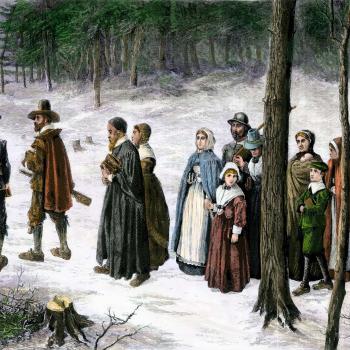I grew up on Answers in Genesis’ materials. I attended a conference keynoted by Ken Ham, and visited the Creation Museum as soon as it opened. But today, as someone who now accepts the science behind evolution, I can’t get over how bizarre and impossible Answers in Genesis’ claims about the earth’s past are.
Answers in Genesis recently published an article titled La Brea Tar Pits.
Did you know that in downtown Los Angeles paleontologists are still digging up fossils from one of the world’s most famous ice age sites?
…
When did the “tar” pits form? The geologic evidence indicates the pits didn’t form until long after the global flood, so the creatures must have lived after the flood too.
Wait, what? Exactly what geologic evidence indicates the La Brea Tar Pits formed after a global flood?
How do we know that? Several events had to take place in sequence. About 1,000 feet (300 m) beneath the park lies what is known as the Salt Lake Oil Field. … Marine algae buried in mudstone deeper down first had to produce the oil. Then the oil had to migrate up to be stored in the sandy beds. …
Next, the moving earth also caused a fault to form … Afterward, sometime during the rapid post-flood ice age (Pleistocene), glacial water then deposited about 200 feet (61 m) of alluvium (silt and clay) over this entire area, sealing all the layers below.
… Earthquakes … eventually opened fractures in the alluvium, enabling crude oil to leak up to the surface, where it collected in pools. … This sticky death-trap arose quite recently, after a long series of geologic events late in the rapid post-flood ice age (after the ice age alluvium was deposited!).
Young earth creationists typically argue that oil fields were formed during the flood. The tar pits formed over the oil fields, after oil leaked up through many layers of silt and clay. Ergo, the creatures trapped in the tar pits lived after the flood, at the end of the post-flood ice age (during which the silt and clay were deposited).
Wait—did they say “rapid” post-flood ice age?
Just how long was the last ice age? I went to look this up, and it seems we’re still in the last ice age. It seems ice age is characterized by ice at the poles, and during an ice age (the current one started 2.5 million years ago) the earth varies between “glacial” periods (growing ice sheets) and “interglacial” periods (retreating ice sheets). The last glacial period occurred from 115,000 to 11,700 years ago. We are currently in an interglacial period.
The animals trapped in the La Brea Tar Pits have been dated to the last glacial period—what Answers in Genesis calls the post-flood Ice Age. Reading this led me to Answers in Genesis’ primary article on this Ice Age.
In reconciling the Ice Age, Answers in Genesis faces a serious problem. There are forests in Antarctica, under all of that ice. The Ice Age, then, can’t start immediately after Noah’s Flood. There has to be time for forests to grow.
But never fear! They have a timeline.
(click here to see the full-sized timeline)
Answers in Genesis argues—based on the Bible—that there were 100 years between the flood and the Tower of Babel, and that it was during these years that Antarctica grew forests. Or rather, it was during the first third of these years—the first human generation—that Antarctica’s forests grew. by the second third, they had already become ice. I don’t know about you, but I am extremely skeptical.
Forests don’t grow from scratch in a single human generation. Not mature forests, at least. I am willing to bet that there are trees in the forests buried under the Antarctic ice that are more than 30 years old. It sounds like I would be right. Also? Antarctica was tundra after it was forest, and before it was covered with ice. Where does that period of Antarctica’s geological history fit this timeline?
(click here to see the full-sized timeline)
Answers in Genesis has the ice age beginning with Babel—in fact, they argue that God might have created the Ice Age on purpose to ensure that people would disperse from Babel, as God had ordered. The Ice Age, according to this timeline, lasted for 250 years, or six human generations.
How much snow would have had to fall for this to have happened? Answers in Genesis includes a handy map that shows that during the Ice Age sea levels were lower, and that the sea beds surrounding the coasts became dry land. You could walk from Ireland to England. Is it even possible for that much water to evaporate and fall as snow, compacting into glaciers, in around a hundred years?
Are you familiar with the Little Ice Age? The period from roughly 1300 to 1850 was characterized by colder winters and cooler summers. And guess what? The glaciers did grow! This period lasted for 500 years, though—not 250—and it never threatened the kind of glaciation present in North America during the height of the last glacial period.
And it’s actually worse than that. The graphic above places the glacial maximum of Answers in Genesis “rapid” Ice Age at roughly 125 years in. After this, the ice still has to melt. So you have to get all of that ice—ice sheets that completely cover most of Europe and North America—in 125 years.
Also, about woolly mammoths. According to Answers in Genesis, there were no woolly mammoths on the Ark. Instead, there was just a single elephant pair. Woolly mammoths evolved after Babel from descendants of that single elephant pair, in one human generation. The scientists at Answers in Genesis are stronger believers in evolution than even I am! (Oh, I’m sorry, microevolution.*)
What’s that? You noticed that their graphic has Neanderthals existing for literally two generations? That’s not how genes work? No, no it is not! And remember—Answers in Genesis has the individuals that became the Neanderthals a generation later present at Babel, speaking the same language as everyone else and interbreeding with them. You’re damn straight that’s not how genes work.
Finally, we need to talk about Egypt.
It is hard to imagine such extreme changes in weather, landscapes, and vegetation during the rapid Ice Age and the years that followed. Some lush places in the north were stricken by drought, while monsoons filled the Sahara Desert with lakes and grasslands, attracting rhinoceroses, crocodiles, and human settlers. For a time at the end of the Ice Age, the drenched Nile Valley was not even habitable (at least, no human artifacts or villages have been found from this time). The great cities of Memphis and Luxor did not arise until many years later.
Answers in Genesis has the Ice Age ending in 2000 BC. At this time, they say, The Nile River Valley was uninhabitable and Memphis and Luxor were yet to be inhabited. This is absurd. Memphis was founded in 3100 BC. I already knew Egypt was a problem for young earth creationists—it was founded hundreds of years before the 2,350 BC date they give for Noah’s Flood—but Answers in Genesis’ dating of the Ice Age pushes the founding of Egypt back still further.
And it’s not just Egypt that’s a problem here.
I mean good gracious. Even Ur is a problem. Ur was already settled by around 5000 BC, which, by the way, is also before young earth creationists’ date for the creation of the world. So there’s that. By 3800 BC—1800 years before young earth creationists have the Ice Age ending—Ur was an established city.
Answers in Genesis exploration of when the Ice Age ended gives us some pointers as to how the organization deals with facts that don’t exactly support their conclusions:
The Bible also sheds light on the Ice Age’s end, though in an indirect way. If we can determine the dates of the first cities built after Babel, including Ur, and then show their relationship with dates for the last human and animal remains from the Ice Age, we can establish approximately when the Ice Age ended.
Just so we’re clear, “determine the dates of the first cities built after Babel” is code for check the Bible, not do archaeology. So you can see that I’m not making that up, here’s what comes next:
The Bible mentions that some very important cities were established by Abraham’s day and continued to thrive throughout Old Testament times.
Yep, totally not making this up.
Since Abraham grew up in Ur, we know that it must have been founded before his birth.
True, that is usually how that works.
And then there’s this:
While the “radiocarbon ages” are wrong because they exceed the Bible’s timeline [this is not how science works], the relative ages are useful. If something dates at 40,000 radiocarbon years and something else at 20,000 or 5,000, we know the first find is older than the second, and so on.
Radiocarbon dating shows that every fossil from the Ice Age predates anything from the earliest known human settlements.
If I’ve kept hold of the thread so far, the argument they’re making is that radiocarbon dating confirms that cities were founded only after the Ice Age (which, yes), and the Bible mentions cities in association with Abraham (okay), ergo, the Ice Age ended before Abraham came onto the scene.
There’s also this odd mention:
In no case do these settlements, including Ur, date as early as the end of the Ice Age. At the time of Ur’s settlement it was a port city on the Persian Gulf, but this gulf did not even exist during the Ice Age.
This combination of Bible and science is giving me whiplash.
Ur can’t actually have been continuously occupied from 38ooo BC on because the Bible says there was a global flood in 2350, and it can’t have been founded immediately after this Flood because science says there was an Ice Age; science says this Ice Age must have occurred after the Flood (because the Ice Age deposits are found on top of the pools of subterranean oil, which of course were created during the Flood); and, finally, science says cities were not founded until after the Ice Age.
Because the Bible says Abraham grew up in Ur—and science says cities were founded only after the Ice Age, and not during it—the Ice Age must have been over by the time Abraham was born.
You see what I’m saying? Answers in Genesis is slopping science onto their religion—but only when they decide to do so—and rejecting science when they conclude it doesn’t fit. The result isn’t something you’d find by looking only at science or only at religion, however. Seriously—comb the Bible, and you won’t find any mention of an Ice Age. It’s not there. Likewise, comb the geological and archeological evidence and you won’t find any evidence of a worldwide flood in 2350 BC.
When Answers in Genesis does glom science to their religious timeline, they frequently do so in ways that make no sense—you can’t fit a global Ice Age the size and scope of the last glacial period into 250 years. To make their timeline work, remember, you have to fit not only the growth of the ice sheets into that period but also their disappearance—remember, their argument is that Ur could not have been settled until the ice had melted, filling the Persian Gulf.
Also? You can’t get a wholly new species of elephant like the woolly mammoth in fifty years. And you can’t get an entirely new species of homo sapiens in two generations. You can’t get a full grown, mature forest (and a full grown tundra on top of it) in thirty years. It does not work like this.
And to think, I once thought this made so much sense.
* Answers in Genesis differentiates between “macroevolution” and “microevolution,” made up terms that allow them to argue that organisms change over time—because that’s pretty much indisputable—but that that does not count as Big-E Evolution. This is how Answers in Genesis can argue that Neanderthals evolved as a separate species in one human generation, but that it would have been impossible for early humans to have evolved from ape-like creatures over millions of years. Cool, huh?
I have a Patreon! Please support my writing!

















